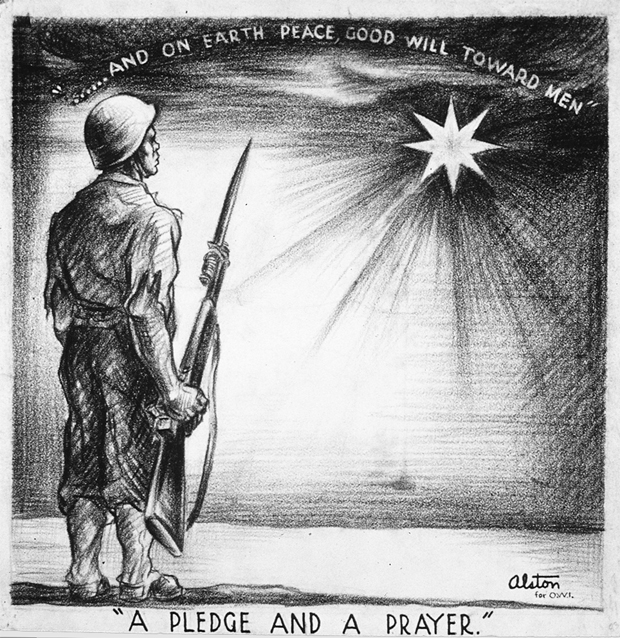Peace on Earth by Charles Henry Alston
EarthDesk presents this image by Charles Henry Alston to honor our veterans, more than 100,000 of whom will be homeless Christmas Day (EarthDesk, December 24). Alston was a painter, muralist, illustrator and sculptor. A central figure in the Harlem Renaissance Movement, he was also companion to some of the towering musical figures of the day:
I knew Ella Fitzgerald when she was a kid. I went with Billie Holiday to her first recording, and I used to sit in Bessie Smith’s rumble seat when she was going to record . . . I was sitting on [Duke] Ellington’s piano when he finished ‘Sophisticated Lady.'”
He created this image while staff artist for the Office of War Information in 1940. More on Charles Henry Alston below.

By Charles Henry Alston, 1907-1977. Via U.S. National Archives and Records Administration
«« »»
 Charles Henry “Spinky” Alston was born in Charlotte, North Carolina on November 28th, 1907. Early artistic influences included illustrated courtship letters by his father, Reverend Primus Priss, to Charles’ mother, Anna Miller. Alston also recalled his older brother’s drawings of cars and trying to copy them. After the death of his father, Alston’s mother married Henry Pierce Bearden (Romare Bearden’s uncle) in 1913 and the family moved to New York City.
Charles Henry “Spinky” Alston was born in Charlotte, North Carolina on November 28th, 1907. Early artistic influences included illustrated courtship letters by his father, Reverend Primus Priss, to Charles’ mother, Anna Miller. Alston also recalled his older brother’s drawings of cars and trying to copy them. After the death of his father, Alston’s mother married Henry Pierce Bearden (Romare Bearden’s uncle) in 1913 and the family moved to New York City.
Alston earned a Masters degree in art education from Columbia’s Teachers College. While still a student, he illustrated album covers for jazz musician Duke Ellington and book covers for poet Langston Hughes. Alston played a major role in the Harlem Renaissance Movement of the period. During the Great Depression, he and sculptor Henry Bannarn directed the Harlem Art Workshop which was funded by the Works Progress Administration Federal Art Project.
Alston painted murals throughout Harlem, including depression-era murals as part of the WPA. One of his best-known murals was created by Alston and other Harlem artists for the Harlem Hospital Center. He later taught at the Art Students League and the City College of New York (CUNY).
This biographical information and more can be found at The Art of Charles Alston website.
A 1965 oral history interview with Alston is here.
Wikimedia Commons has an extensive collection of Alston’s works here.
«« »»

